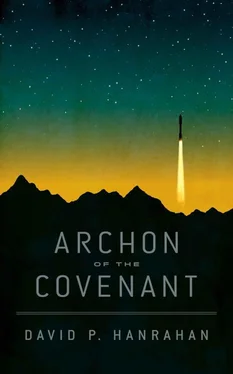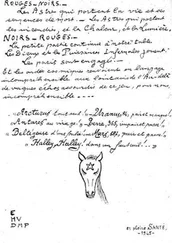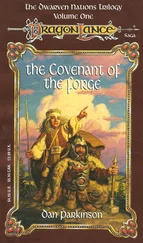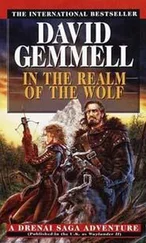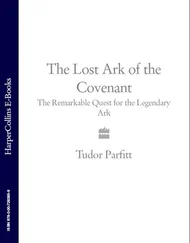The two families who had escaped High Jinks Ranch had been doomsday soothsayers. The Helwigs and Dolans. They had built underground shelters years before the air spoiled. They had lived in contained bunkers until their own foodstuffs had depleted. On the verge of death, they gathered together above ground wearing a mix of gas masks and SCUBA tanks. They agreed to retreat into the Santa Catalinas, hoping and praying that the air would be pure in the higher elevation. They had packed up what they had and ventured into the foothill basin, coming across the abandoned High Jinks Ranch. Here they stayed, agreeing to hold off their ascent until the air warmed again in the Spring. They had been watched ever since their car engines turned over in the garages outside of their bunkers. The Oracle pack — a violent and structured swarm — was aware of these two families. They saw the children and grandfather get into the passenger doors. They tracked the family — the clean scent of the showered wives wafting into the air, filling the night where the blooms of desert broom had vanished into the ether. One of the wives, Michelle, sat atop stone steps leading up to the main lodge of the ranch, looking into the desert floor during their first evening at the ranch. She had noticed her gas mask was loose. She broke down, sitting on the steps, flinging her mask into the dusk air. She sobbed, rubbing her eyes, then laughed. She laughed at the senselessness and futility of her life. She dried her eyes and took in the horizon of Sonora. She held a pistol in one hand, clicking off the safety. She closed her eyes and pulled the gun to her head — with her eyes closed, she heard a series of distant bleats, and yucca rustling in the still autumn night. She opened her eyes and saw them — hundreds of revins descending upon them from the northern pass. She screamed, running back to the ranch to warn the others.
DDC39 stood in the main entranceway of the lodge. The steps where Michelle had sat were awash in dried blood and bone fragments. Around the ranch, scores of revin bodies were shot through — falling to rest in contorted positions. One sat atop a well, having expired with a gun shot in the chest, seated on the wall of the well — a peaceful look on its face. The preservation of the revin bodies suggested this chaos had occurred in the not too distant past.
The families had barricaded themselves inside and fired at the oncoming horde. The sentinel rolled inside the lodge, the metallic din of hundreds of bullet casings crumpling underneath its tri-axel. A set of gas masks were piled in the corner, unceremoniously retired in the firefight. Dead revin bodies had come to rest in the broken windowsills — holes blasted through their skulls. The sentinel continued upstairs, coming across the first of the survivor’s bodies — a man, a father, who had tried to keep them at bay on the first floor. His remains were picked through. Tattered flannel clothes and broken bones — the only testament to his life. The revins had kept coming, undeterred by the cacophony of screams and gunshots — they had instead been stirred to frenzy by the scene.
On the 2nd floor, the sentinel had found the rest of the two families. A large wooden door had been broken down, leading to the main bedroom where the families had made their last stand. The sentinel rolled over a pile of revin bodies in the doorway until it could see inside the room. The last father had shot every survivor in the head, then himself, and it was over. The revins had swarmed in the room, violating the warm bodies and pulling them apart. The color of the room was maroon: the marker of mans devolution. A pile of cracked bones and skulls were strewn about the room along with shreds of clothes, shoes in child and adult sizes. The sentinel scanned the complex — no heat signatures, but no dust either. A dirty book was on a ledge in the corner — miraculously free of blood. The sentinel rolled over to the ledge and tipped its finger over the front cover, peeling the book’s title into the light: “Oh The Places You’ll Go” by Dr. Seuss. It plucked the book from the shelf and dropped it into a small chamber that clicked open on its base.
* * *
Now, in December, the sentinel stood perched on a ledge high atop Mt. Lemmon, looking down at the High Jinks Ranch in the distance. The snow flurries swirled around the sentinel, coming to rest on its trident arm. The sentinel clicked open the chamber and looked at the book once more. The sun had started to set in the horizon. DDC39 was silent, still. The evening sky was clear and the Perseus constellation shown down on the sentinel in its solitude. It began its shutdown procedures and went into standby mode in the cold night, high above Tucson and the desert floor.
• Solar power cell — 20%. Solar armor — 100%.
• Drivetrain — operational
• Visual/cortico/thermal/radar optics — operational
• HD/Comms — operational
• Water — 100%. Napalm — 100%
• Railgun — full capacity
• JE — discovered evidence of vaccine introduction; more death
• Shutting down core operation and initiating stand-by mode
6. Fading Signals, Drone Cities
The sentinel was caught in a snowstorm at the top of Mt. Lemmon. Unable to keep a charge, it came to a stop on Ski Run Road in Summerhaven, the empty lifts listing in the distance. A wind swept through the mountaintop obscuring all but the dark cabin fronts in the whiteout of the storm. There had been a track that the sentinel was following — a fast-moving pack of human/revin steps. Now, nothing. The sentinel was buried up to its trident base — two feet of snow having fallen overnight. The winds picked up to 40 mph, the sentinel swaying gently in the violent gusts. Heat optics showed no living creatures. Even the wolves had the foresight to seek shelter in advance of the sudden storm.
Around 330PM, the winds calmed and the sky broke for the first time. Brief rays of light struck the sentinels solar armor and its secondary systems came back online. The sentinel scanned around. Two hot air balloons had entangled in a towering thicket of ponderosa nearby. A skeletal figure hung in the suspension cables, its ossified hand still clasped around the valve cord. Beneath the trees, in an open clearing, scraps of blue tattered cloth flapped in the wind, half sunk in the snow. The sentinel clicked through its optics: thermal, black light, x-ray. Beneath the snow, gathered below the wicker baskets of the tangled dirigibles, were the deceased bodies of a group of Boy Scouts from Camp Lawton. All death, all the time, surrounding the fading signals of man’s binary spine.
* * *
Early the next morning, the sentinel moved out going south along the Mt. Lemmon Highway, slogging through the undisturbed snow banks. From a ledge on the steep road, the sentinel looked out into the depths of the Coronado Forest. Obscured in the distance would be the ruins of Tucson. Far beneath the ledge, miles down the road, the snow thinned out as the elevation receded into Sabino Canyon. Here, in 1450 AD, the Hohokam people dwelled in pit houses and irrigated the soil of Sonora. They carved their stories into canyon walls, crafted ceramics and jewelry from turquoise, and then vanished, never to be found. The desert dwellers of the Southwest became the O’odham through ethnogenesis and the arrival of the Spaniards in the 1600s, then fractured upon the Anglo-Saxon arrival and eastward tide of manifest destiny.
In the sky, high above the sentinel, three figures circled in unison. The sentinel switched into zoom optics, panning into their path as they began to bank out of view. And then they vanished, disappearing north behind Butterfly Peak.
The snow continued to thin as the sentinel made its way slowly down the highway. Beyond Rose Canyon Lake, near the switchbacks of Bear Canyon, the sentinel came across a convoy of camper trailers that had come to a halt in the middle of the road. A large flatbed truck had been steered perpendicular to the lanes, blocking all traffic ascending the mountain. A series of fresh tracks came off the berm to the right, crossing through the road and circling the trailers, and then descended left down the steep decline. The sentinel switched into thermal optics and imaged the decay of the tracks. It came to a halt and listened. Water trickled down the embankments of the road from the melting snow. Something was breathing. The sentinel detected trace bile and hydrogen sulfide — the gut flora of revin excrement.
Читать дальше
